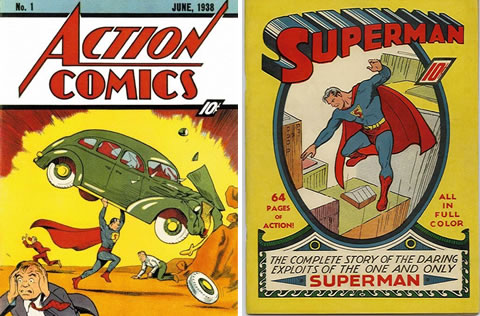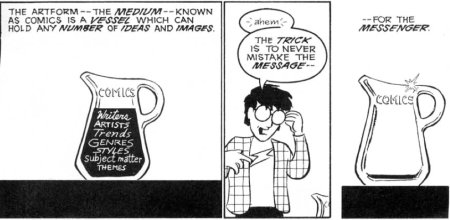But what exactly is a graphic novel? There is a lot of confusion on this topic, and we would like to clear some of that up for you.
At its most basic, a graphic novel is a book that tells its story using sequential graphics, which is a fancy way of saying that it looks like a comic book inside. Finace and I actually once had about a ten minute argument about why they're called graphic novels now and not comic books.

That doesn't mean it's all bright colors and superheroes and saving the day. In fact, graphic novels tend to fall into one of two categories. The first is exactly what you think of when you hear "comic book." A caped crusader rescuing a damsel, a city, or the world from certain peril, and punching the villain square in the chin before teaching Little Timmy that drugs and littering are bad. (Side note: I've actually noticed that once our beloved time-tested superheroes make the switch from comic book story arcs to graphic novel story arcs, they tend to get, well, dark. But that is probably due more to the fact that today's audience wants their Peter Parker emo and their Bruce Wayne emotionally tortured and their Clark Kent weeping, not so much because of the format. Actually, I prefer Clark Kent upbeat. I mean, tortured Wayne, fine, but a woobie Superman? That's just not right.)
The other category is... well, everything else. Graphic novels cover every type of story that you can find in regular novels: romance, drama, adventure, fantasy, science-fiction, historical fiction, non-fiction.

Usually, your typical graphic novel has the same layout as comic books, with the panels creating subdivisions of the page (some larger than others) and speech bubbles delivering dialogue while any other pertinent information is tucked away in neat little narration panels. Every illustrator has their own way, though, and you start to get a feel for each of them as you read more of their work.
There is also the wordless graphic novel, sometimes referred to as a "silent" graphic novel. I'm not going to lie; these aren't exactly my preference. I like some WORDS with my GN. Otherwise, I wouldn't really consider it a graphic novel, just... graphic. If the name didn't give it away, these are graphic novels that have no words in them (except maybe the occasional onomatopoeia*). If you've never read a graphic novel before, and you aren't very familiar with comic books, you probably shouldn't start with a wordless graphic novel. You have to teach yourself to "read the images," which is very different from reading words. It takes time to look at the entire page, absorbing all the information being presented by the visual details. You can't just flip through the images quickly, like so many non-GN-readers tend to do; you're missing a lot if you do it that way. So if you're used to picture-less novels, ease into the world of graphic novels with some wordier ones, and remember to balance the time your eyes are on text with the time your eyes are on images.
There is a lot of contention, in the world of people who think about these things for a living or a hobby, as to whether manga "counts" as graphic novels. Manga is a Japanese term that refers to a particular style of drawing, but also to a form of book that is, essentially, a graphic novel: a story told using pictures and speech bubbles and narration panels. (Side note: If you go pick up your first manga and get really confused almost immediately, you're supposed to read it backwards. Start at the "back" cover and work your way "forward." That should help clear things up.) Sailor Moon was the first Manga I read. And, apparently, they're starting it up again (not the Manga, the animated series, though it's entirely possible the Manga might also resurface.) Just a little side-note there for all the nostalgic SM readers we have.
 |
| Yup, that's manga. It's the half naked chick that gives it away. |
The format really gained momentum in the 1980s, though, with behemoths of the field like Watchmen and Maus being published, along with anthologies of already-popular comic books (Batman: The Dark Knight Returns and Sandman come to mind).
Since then, brilliant authors and brilliant illustrators have worked together to bring you brilliant pieces of literature in the graphic novel format.
Besides the aforementioned titles, some of the most popular graphic novels to date include: Persepolis, Ghost World, Blankets, 300, Sin City, Kick-Ass, The Men in Black, Mystery Men, Road to Perdition, Scott Pilgrim Vs. The World, V for Vendetta and so many more.
If you're interested in trying your hand at some wordless graphic novels, you might want to start with some of these, as they're all highly regarded: The Arrival, Mister O, Graphic Witness: Four Wordless Graphic Novels, and God's Man.
If you're still totally lost but we've piqued your interest, go pick up a copy of Understanding Comics: The Invisible Art by Scott McCloud. He does an absolutely incredible job of explaining everything you need to know about graphic novels.
 |
| From Scott McCloud's Understanding Comics: The Invisible Art |
*onomatopoeia: a "sound word" like BUZZ or ZAP or WHOOSH or ZZZ or BANG. These show up in wordless graphic novels because it makes more sense to write "BANG" over an image of a gun than it is to write a narration panel stating, "The gun went off with a loud bang." It gets even more interesting when you pay attention to the illustrative choices used with onomatopoeia. The gunshot "BANG" will look different from the "BANG" of a kid dropping a stack of textbooks on a table.
Have you guys read The Invention of Hugo Cabret? I would argue that it is close to a graphic novel. It has words, but two thirds of the story is told in images. You should check it out. It falls between Steampunk and Historical Fiction.
ReplyDeleteI have read it (as has Alex) though it's been awhile. It is mostly images, and I guess a case can be made for it being a graphic novel, the difference is, Graphic Novels are usually told in panels. Hugo Cabret is not. It's page by page and also, the pages are full text, not speech bubbles like graphic novels are. That's why I would throw it into the picture book category before I would throw it into the GN category.
DeleteBut keep an eye out during the week of 11/26. I've heard a little rumor that Hugo might pop up that week. ;)
Yep, Cassy beat me to it, but yes I did read it, and I very much enjoyed it, AND it will be showing up soon on the blog.
Delete